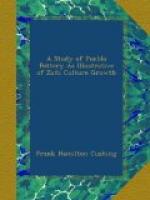In a majority of the lava ruins (for example those occurring near Prescott, Arizona), I have observed that the sloping sides rather than the level tops of mesa headlands have been chosen by the ancients as building-sites. Here, the rude, square type of building prevails, not, however, to the entire exclusion of the circular type, which, is represented by loosely constructed walls, always on the outskirts of the main ruins. The rectangular rooms are, as a rule, built row above row. Some of the houses in the upper rows give evidence of having overlapped others below. (See section, Fig. 495.)
FLAT AND TERRACED ROOFS DEVELOPED FROM SLOPING MESA-SITES.
We cannot fail to take notice of the indications which this brings before us.
(1) It is quite probable that the overlapping resulted from an increase in the numbers of the ancient builders relative to available area, this, as in the first instance, leading to a further massing together of the houses. (2) It suggested the employment of rafters and the formation of the flat roof, as a means of supplying a level entrance way and floor to rooms which, built above and to the rear of a first line of houses, yet extended partially over the latter. (3) This is I think the earliest form of the terrace.
[Illustration: FIG. 495.—Section illustrating evolution of flat roof and terrace]
It is therefore not surprising that the flat roof of to-day is named te k’os kwin ne, from te, space, region, extension, k’os kwi e, to cut off in the sense of closing or shutting in from one side, and kwin ne, place of. Nor is it remarkable that no type of ruin in the Southwest seems to connect these first terraced towns with the later not only terraced but also literally cellular buildings, which must be regarded nevertheless as developed from them. The reason for this will become evident on further examination.
[Illustration: FIG. 496.—Perspective view of a typical solitary house.]
[Illustration: FIG. 497.—Plan of a typical solitary house.]
The modern name for house is k’ia kwin ne, from k’ia we, water, and kwin ne, place of, literally “watering place;” which is evidence that the first properly so called houses known to the Pueblos were solitary and built near springs, pools, streams, or well-places. The universal occurrence of the vestiges of single houses throughout the less forbidding tracts of the Pueblo country (see Figs. 496 and 497) leads to this inference and to the supposition that the necessity for protection being at last overcome, the denizens of the lava-fields, where planting was well-nigh impossible, descended, building wherever conditions favored the horticulture which gradually came to be their chief means of support. As irrigation was not known until long afterwards, arable areas were limited, hence they were compelled




